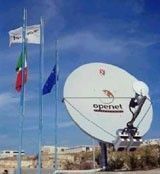
-
StatusCompleted
-
Status date2014-12-09
The Teseo project (Teletourism Extended Service for Extensive Operators) - wishes to realize a system of multimedia narrow casting satellite communication. The different multimedia contents are going to be distributed to users situated in different places in order to transmit video, audio, graphics and text to a local channel. The channel will be used by receiving hotel structures in a differentiated simulcast format.
The system peculiarity allows different information producers and even prosumers to take part to the creation of information. In this way they are supposed to contribute to the realization of an information service basically focused on local areas. ("glocal" = global + local).
In order to develop his project, Openet Technologies disposes of its own up-link satellite station based on Alenia Spazio SkyplexNet Platform. Alenia Spazio and Space Software Italia are both Finmeccanica companies and sponsoring partners of this project. Matera and Bari are the geographic areas involved in the project, particularly their hotels, travel agencies and tourists organizations.
The project has two fundamental aims: to demonstrate both satellite technology commercial value when applied to tourist information systems, and assuring a friendly access to the new systems by people without any technological skill.
| SkyPlexNet uplink station of Openet, in Matera (Southern Italy) |
<BR
The principal challenges which the project addresses are:
- The TESEO philosophy, that is to grant the friendly access to advanced technologies, to basic users without implementing difficult learning.
- The development of an open architecture of information delivery, that can simply enhanced from different sources and users, and through a complex multi-channel system, including digital cell phone, broadcast television, and many other.
This project completely innovates the tourist information system of today.
Since now these kind of contribution were always printed on paper which was subjected to obsolescence and degradation. Moreover, in most of cases information are not assembled in a fluent outline. Indeed they are often the result of different and separate productions.
Teseo wants to realize a platform opened to all kind of contribution.
The system will be able to generate a shared cost-cutting measure thanks to digital documents and frequent updating. The system could be employed by b2b clients (i.e., hotel chains) in order to conform brand communication over their networks, particularly towards those clients who are the target of loyalty promotion. Information localization will also allow clients to be divided and classified in market segments, to promote oriented products joined to their standard of living.
Teseo system architecture is composed of the following four major elements:
- The Content Provider creates and sends to the Content Server a gathering of tourist and entertainment information, converting them to digital multimedia format. Management and delivering of all information are prepared within the Openet Technologies editorial office.
- The Broadcast Video Service adapts part of most important information to the A/V broadcast format. It is placed within Openet Technologies offices, too.
- The Service Center, co-located with the SkyPlexNet up-link station inside Openet Technologies. It is basically composed of two major components: the first strictly linked to service management, the second connected to all supervision and control functions which have to be considered common to all applications. Into the latter class can be also included all the elements needed to handle the end user and the interactive channel interface. Main subsystem composing the Service Center are: transaction server, content server, service scheduler and control, a conditional access system, an Internet server and a DVB/IP Gateway.
- The DVB/IP Client Platform at the end user premises. He is equipped with:
- A PC with a multimedia kit, enough powerful to join the services;
- A Data Browser User System, with navigation Software and the data receiving card to put on the PC; No connection to the Internet is required to receive all information.
Elements 3 and 4 architectures can be partially in common with other SkyPlexNet system ones.
Teseo Project has been divided in the following phases:
- Pilot System Development, defining in detail the system architecture, will be completed in January 2002.
- Documentation System Set up, which includes editorial office tailoring and broadcast video service customizing; will be completed in January 2002. Pilot Operations is going to start and will be completed within April/May 2002.
The Final Review of the TESEO Project was held on 14th February 2003.
In addition to the original requirements and goals, the project has also developed interesting improvements such as the broadcasting of live TV on demand, at full screen broadcast quality.
A considerable number of public and private companies have shown appreciation for the project during its pilot phase and thanks to their specific demands, new business TV services have been developed.
One of the most important reasons for the success of the Teseo platform is its flexibility: it can be used not only by tourist organisations but also as a means of communication for other types of business. For tourism purposes, Teseo can easily be used as a stand-alone facility for local information (e.g. a kiosk) as well as in large European hotel chains for most marketing requirements (cross selling, customer loyalty and satisfaction).
The future developments of the project will be oriented towards an improved wireless-based interactive kiosk.



